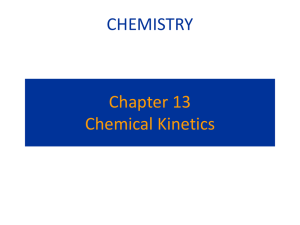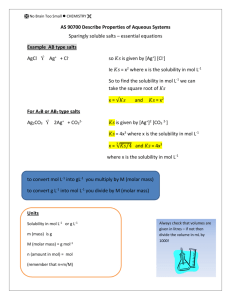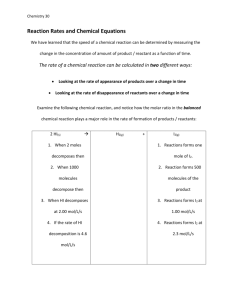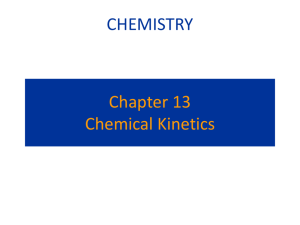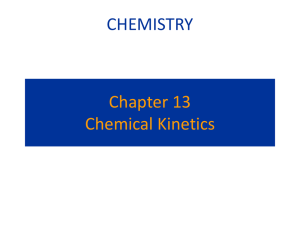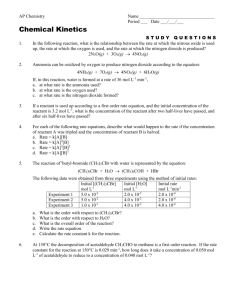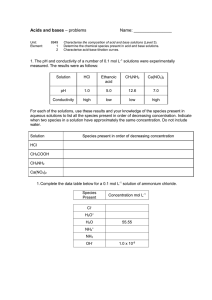Rate Laws and Order of Reaction 381 # 7 - 9
advertisement
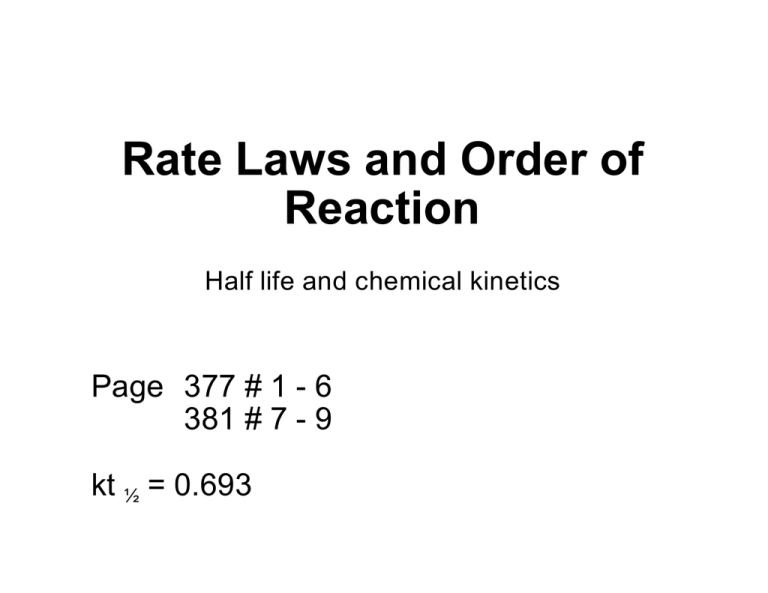
Rate Laws and Order of Reaction Half life and chemical kinetics Page 377 # 1 - 6 381 # 7 - 9 kt ½ = 0.693 Factors that Affect Reaction Rate 1. Temperature • • Collision Theory: When two chemicals react, their molecules have to collide with each other with sufficient energy for the reaction to take place. Kinetic Theory: Increasing temperature means the molecules move faster. 2. Concentrations of reactants • More reactants mean more collisions if enough energy is present 3. Catalysts • Speed up reactions by lowering activation energy 4. Surface area of a solid reactant • Bread and Butter theory: more area for reactants to be in contact 5. Pressure of gaseous reactants or products • Increased number of collisions The Rate Law The rate law expresses the relationship of the rate of a reaction to the rate constant and the concentrations of the reactants raised to some powers. aA + bB cC + dD Rate = k [A]x[B]y reaction is xth order in A reaction is yth order in B reaction is (x +y)th order overall THE RATE EQUATION links the rate of reaction to the concentration of reactants can only be found by doing actual experiments cannot be found by just looking at the equation r k [] the equation... A + B ——> C + D might have a rate equation like this r = k [A] [B]2 rate of reaction rate constant concentration units of units units of -1 conc. / time usually mol L s -1 depend on the rate equation 1 litre = 1 dm 3 mol L -1 Interpretation The above rate equation tells you that the rate of reaction is.. . proportional to the concentration of reactant A doubling [A] doubles rate proportional to the square of the concentration of B doubling [B] quadruples (2 2 ) rate ORDER OF REACTION Order tells you how much the concentration of a reactant affects the rate Individual order The power to which a concentration is raised in the rate equatio n Overall order The sum of all the individual orders in the rate equation. ORDER OF REACTION Order tells you how much the concentration of a reactant affects the rate Individual order The power to which a concentration is raised in the rate equatio n Overall order The sum of all the individual orders in the rate equation. Value(s) e.g. in the rate equation and the order with respect to A is the order with respect to B is the overall order is r = k [A] [B] 2 1 2 3 1st Order 2nd Order 3rd Order need not be whole numbers can be zero if the rate is unaffected by how much of a subst ance is present ORDER OF REACTION Order tells you how much the concentration of a reactant affects the rate Individual order The power to which a concentration is raised in the rate equatio n Overall order The sum of all the individual orders in the rate equation. Value(s) e.g. in the rate equation and the order with respect to A is the order with respect to B is the overall order is r = k [A] [B] 2 1 2 3 1st Order 2nd Order 3rd Order need not be whole numbers can be zero if the rate is unaffected by how much of a subst ance is present NOTES The rate equation is derived from experimental evidence not by looking at an equation. Species appearing in the stoichiometric equation sometimes aren't in the rate equation. Substances not in the stoichiometric equation can appear in the rate equation - CATALYSTS Rate Laws • Rate laws are always determined experimentally. • Reaction order is always defined in terms of reactant (not product) concentrations. • The order of a reactant is not related to the stoichiometric coefficient of the reactant in the balanced chemical equation. F2 (g) + 2ClO2 (g) 2FClO2 (g) rate = k [F2][ClO2] 1 13.2 THE RATE EQUATION Experimental determination of order Method 1 Plot a concentration / time graph qnd calculate the rate (gradient) at points on the curve Plot another graph of the rate (y axis) versus the concentration at that point (x axis) If it gives a straight line, the rate is directly proportional t o concentration - 1st ORDER. If the plot is a curve then it must have another order. Try plo tting rate v. (conc.) 2. A straight line would mean 2nd ORDER. This method is based on trial and error. THE RATE EQUATION Experimental determination of order Method 1 Plot a concentration / time graph qnd calculate the rate (gradient) at points on the curve Plot another graph of the rate (y axis) versus the concentration at that point (x axis) If it gives a straight line, the rate is directly proportional t o concentration - 1st ORDER. If the plot is a curve then it must have another order. Try plo tting rate v. (conc.)2. A straight line would mean 2nd ORDER. This method is based on trial and error. Method 2 - The initial rates method. Do a series of experiments (at the same temperature) at differen t concentrations of a reactant but keeping all others constant. Plot a series of conc entration / time graphs and calculate the initial rate (slope of curve at start) for eac h reaction. From the results calculate the relationship between concentration and rate and he nce deduce the rate equation. To find order directly, logarithmic plots are requir ed. THE RATE CONSTANT (k) Units The units of k depend on the overall order of reaction. e.g. if the rate equation is... rate = k [A] 2 the units of k will be dm 3 mol -1 sec -1 Divide the rate by as many concentrations as appear in the rate equation. Overall Order: 0 units of k: mol L- 1 sec -1 1 sec -1 example in the rate equation r = k [A] in the rate equation r = k [A] [B] 2 2 L mol -1 sec -1 3 L 2 mol-2 sec -1 k will have units of sec -1 k will have units of L 2 mol -2 sec -1 RATE EQUATION - SAMPLE CALCULATION r [] [A] [B] Initial rate (r) 1 0.5 1 2 2 1.5 1 6 3 0.5 2 8 initial rate of reaction concentration mol L -1 s -1 mol L -1 In an experiment between A and B the initial rate of reaction was found for various starting concentrations of A and B. Calculate... • • • • • the the the the the individual orders for A and B overall order of reaction rate equation value of the rate constant (k) units of the rate constant RATE EQUATION - CALCULATING ORDER OF [A] [A] [B] Initial rate (r) 1 0.5 1 2 2 1.5 1 6 3 0.5 2 8 Compare Experiments 1 & 2 [B] same [A] 3 x bigger rate 3 x bigger \ rate " [A] FIRST ORDER with respect to (wrt) A CALCULATING ORDER wrt A Choose any two experiments where... [A] is changed and, importantly, [B] is KEPT THE SAME See how the change in [A] affects the rate As you can see, tripling [A] has exactly the same effect on the rate so... THE ORDER WITH RESPECT TO A = 1 (it is FIRST ORDER) RATE EQUATION - CALCULATING ORDER OF [B] CALCULATING ORDER wrt B Choose any two experiments where... [B] is changed and, importantly, [A] is KEPT THE SAME See how a change in [B] affects the rate As you can see, doubling [B] quadruples the rate so... THE ORDER WITH RESPECT TO B = 2 It is SECOND ORDER [A] [B] rate [A] [B] Initial rate (r) 1 0.5 1 2 2 1.5 1 6 3 0.5 2 8 Compare Experiments 1 & 3 same 2 x bigger 4 x bigger \ rate " [B]2 SECOND ORDER wrt B RATE EQUATION - CALCULATING OVERALL ORDER [A] [B] Initial rate (r) 1 0.5 1 2 2 1.5 1 3 0.5 2 [A] [B] Initial rate (r) 1 0.5 1 2 6 2 1.5 1 6 8 3 0.5 2 8 Compare Experiments 1 & 2 [B] same [A] 3 x bigger rate 3 x bigger \ rate " [A] [A] [B] rate FIRST ORDER with respect to (wrt) A OVERALL ORDER Compare Experiments 1 & 3 same 2 x bigger 4 x bigger \ rate " [B]2 SECOND ORDER wrt B = THE SUM OF THE INDIVIDUAL ORDERS = 1 + 2 = 3 RATE EQUATION - OVERALL EQUATION [A] [B] Initial rate (r) 1 0.5 1 2 2 1.5 1 3 0.5 2 [A] [B] Initial rate (r) 1 0.5 1 2 6 2 1.5 1 6 8 3 0.5 2 8 Compare Experiments 1 & 2 [B] same [A] 3 x bigger rate 3 x bigger \ rate " [A] [A] [B] rate FIRST ORDER with respect to (wrt) A \ rate = k [A] [B]2 Compare Experiments 1 & 3 same 2 x bigger 4 x bigger \ rate " [B]2 SECOND ORDER wrt B By combining the two proportionality relationships you can construct the overall rate equation RATE EQUATION - CALCULATING K WITH UNITS [A] [B] Initial rate (r) 1 0.5 1 2 2 1.5 1 3 0.5 2 [A] [B] Initial rate (r) 1 0.5 1 2 6 2 1.5 1 6 8 3 0.5 2 8 Compare Experiments 1 & 2 [B] same [A] 3 x bigger rate 3 x bigger \ rate " [A] [A] [B] rate FIRST ORDER with respect to (wrt) A \ rate = k [A] [B]2 re-arranging k = rate [A] [B] 2 Compare Experiments 1 & 3 same 2 x bigger 4 x bigger \ rate " [B]2 SECOND ORDER wrt B Chose one experiment (e.g. Expt. 3) and substitute its values into the rate equation k = 8 (0.5) (2) 2 = 4 L 2 mol -2 sec -1 RATE EQUATION - SAMPLE CALCULATION [A] [B] Initial rate (r) 1 0.5 1 2 2 1.5 1 3 0.5 2 [A] [B] Initial rate (r) 1 0.5 1 2 6 2 1.5 1 6 8 3 0.5 2 8 Compare Experiments 1 & 2 [B] same [A] 3 x bigger rate 3 x bigger \ rate " [A] [A] [B] rate FIRST ORDER with respect to (wrt) A \ rate = k [A] [B]2 re-arranging SUMMARY SUMMARY k = rate [A] [B] 2 Compare Experiments 1 & 3 same 2 x bigger 4 x bigger \ rate " [B]2 SECOND ORDER wrt B Chose one experiment (e.g. Expt. 3) and substitute its values into the rate equation k = 8 (0.5) (2) 2 = 4 L 2mol -2 sec -1 RATE EQUATION QUESTIONS [A] / mol L-1 No No 11 Expt 1 Expt 2 Expt 3 CALCULATE 0.25 0.25 0.50 [B] / mol L-1 0.25 0.50 0.25 THE THE THE THE THE Rate / mol L-1 s-1 4 8 8 ORDER WITH RESPECT TO A ORDER WITH RESPECT TO B OVERALL ORDER OF REACTION FORMAT OF THE RATE EQUATION VALUE AND UNITS OF THE RATE CONSTANT ANSWER ANSWER RATE EQUATION QUESTIONS [A] / mol L-1 No No 11 Expt 1 Expt 2 Expt 3 0.25 0.25 0.50 [B] / mol L-1 0.25 0.50 0.25 [B] is doubled rate " [B] Rate / mol L-1 s-1 4 8 8 Expts 1&2 [A] is constant Therefore Rate is doubled 1st order wrt B Explanation: What was done to [B] had exactly the same effect on the rate ANSWER ANSWER RATE EQUATION QUESTIONS [A] / mol L-1 No No 11 Expt 1 Expt 2 Expt 3 Expts 1&2 Explanation: 0.25 0.25 0.50 [B] / mol L-1 0.25 0.50 0.25 Rate / mol L-1 s-1 4 8 8 [A] is constant [B] is doubled Rate is doubled Therefore rate " [B] 1st order wrt B What was done to [B] had exactly the same effect on the rate Expts 1&3 [B] is constant Therefore [A] is doubled rate " [A] Rate is doubled 1st order wrt A Explanation: What was done to [A] had exactly the same effect on the rate ANSWER ANSWER RATE EQUATION QUESTIONS [A] / mol L-1 No No 11 Expt 1 Expt 2 Expt 3 Expts 1&2 Explanation: Expts 1&3 0.25 0.25 0.50 [B] / mol L-1 0.25 0.50 0.25 Rate / mol L-1 s-1 4 8 8 [A] is constant [B] is doubled Rate is doubled Therefore rate " [B] 1st order wrt B What was done to [B] had exactly the same effect on the rate Explanation: [B] is constant [A] is doubled Rate is doubled Therefore rate " [A] 1st order wrt A What was done to [A] had exactly the same effect on the rate Rate equation is r = k[A][B] ANSWER ANSWER RATE EQUATION QUESTIONS [A] / mol L-1 No No 11 Expt 1 Expt 2 Expt 3 Expts 1&2 Explanation: Expts 1&3 0.25 0.25 0.50 [B] / mol L-1 0.25 0.50 0.25 Rate / mol L-1 s-1 4 8 8 [A] is constant [B] is doubled Rate is doubled Therefore rate " [B] 1st order wrt B What was done to [B] had exactly the same effect on the rate Explanation: [B] is constant [A] is doubled Rate is doubled Therefore rate " [A] 1st order wrt A What was done to [A] had exactly the same effect on the rate Rate equation is r = k[A][B] Value of k Substitute numbers from Exp 1 to get value of k k = rate / [A][B] = 4 / 0.25 x 0.25 = 64 ANSWER ANSWER RATE EQUATION QUESTIONS [A] / mol L-1 No No 11 Expt 1 Expt 2 Expt 3 Expts 1&2 Explanation: Expts 1&3 [B] / mol L-1 0.25 0.25 0.50 0.25 0.50 0.25 Rate / mol L-1 s-1 4 8 8 [A] is constant [B] is doubled Rate is doubled Therefore rate " [B] 1st order wrt B What was done to [B] had exactly the same effect on the rate Explanation: [B] is constant [A] is doubled Rate is doubled Therefore rate " [A] 1st order wrt A What was done to [A] had exactly the same effect on the rate Rate equation is r = k[A][B] Value of k Substitute numbers from Exp 1 to get value of k k = rate / [A][B] = 4 / 0.25 x 0.25 = 64 Units of k rate / conc x conc = r = 64[A][B] L mol -1 s -1 RATE EQUATION QUESTIONS [C] / mol L-1 No No 22 Expt 1 Expt 2 Expt 3 CALCULATE 0.40 0.20 0.40 THE THE THE THE THE [D] / m mol L-1 0.40 0.40 1.20 Rate / mol L-1 s-1 0.16 0.04 1.44 ORDER WITH RESPECT TO C ORDER WITH RESPECT TO D OVERALL ORDER OF REACTION FORMAT OF THE RATE EQUATION VALUE AND UNITS OF THE RATE CONSTANT ANSWER ANSWER RATE EQUATION QUESTIONS [C] / mol L-1 No No 22 Expt 1 Expt 2 Expt 3 0.40 0.20 0.40 [D] / mol L-1 0.40 0.40 1.20 [D] is tripled rate " [D]2 Rate / mol L-1 s-1 0.16 0.04 1.44 Expts 1&3 [C] is constant Therefore Rate is 9 x bigger 2nd order wrt D Explanation: Squaring what was done to D affected the rate (3 2 = 9) ANSWER ANSWER RATE EQUATION QUESTIONS [C] / mol L-1 No No 22 Expt 1 Expt 2 Expt 3 Expts 1&3 Explanation: 0.40 0.20 0.40 [D] / mol L-1 0.40 0.40 1.20 Rate / mol L-1 s-1 0.16 0.04 1.44 [C] is constant [D] is tripled Rate is 9 x bigger Therefore rate " [D]2 2nd order wrt D Squaring what was done to D affected the rate (3 2 = 9) Expts 1&2 [D] is constant Therefore [A] is halved rate " [C] 2 Explanation: One half squared = one quarter Rate is quartered 2nd order wrt C ANSWER ANSWER RATE EQUATION QUESTIONS [C] / mol L-1 No No 22 Expt 1 Expt 2 Expt 3 Expts 1&3 Explanation: Expts 1&2 0.40 0.20 0.40 [D] / mol L-1 0.40 0.40 1.20 Rate / mol L-1 s-1 0.16 0.04 1.44 [C] is constant [D] is tripled Rate is 9 x bigger Therefore rate " [D]2 2nd order wrt D Squaring what was done to D affected the rate (3 2 = 9) Explanation: [D] is constant [A] is halved Therefore rate " [C] 2 One half squared = one quarter Rate equation is r = k[C] 2 [D] 2 Rate is quartered 2nd order wrt C ANSWER ANSWER RATE EQUATION QUESTIONS [C] / mol L-1 No No 22 Expt 1 Expt 2 Expt 3 Expts 1&3 Explanation: Expts 1&2 [D] / mol L-1 0.40 0.20 0.40 Rate / mol L-1 0.40 0.40 1.20 s-1 0.16 0.04 1.44 [C] is constant [D] is tripled Rate is 9 x bigger Therefore rate " [D]2 2nd order wrt D Squaring what was done to D affected the rate (3 2 = 9) Explanation: [D] is constant [A] is halved Therefore rate " [C] 2 One half squared = one quarter Rate equation is r = k[C] 2 [D] 2 Value of k Substitute numbers from Exp 2 to get value of k k = rate / [C] 2 [D] 2 = 0.04 / 0.2 2 x 0.4 2 = 6.25 Units of k rate / conc 2 x conc 2 = L3 mol-3 s -1 Rate is quartered 2nd order wrt C RATE EQUATION QUESTIONS [E] / mol L-1 No No 33 Expt 1 Expt 2 Expt 3 CALCULATE 0.40 0.80 0.80 [F] / mol L-1 0.40 0.80 1.20 THE THE THE THE THE Rate / mol L-1 s-1 0.16 0.32 0.32 ORDER WITH RESPECT TO E ORDER WITH RESPECT TO F OVERALL ORDER OF REACTION FORMAT OF THE RATE EQUATION VALUE AND UNITS OF THE RATE CONSTANT ANSWER ANSWER RATE EQUATION QUESTIONS [E] / mol L-1 No No 33 Expt 1 Expt 2 Expt 3 0.40 0.80 0.80 [F] / mol L-1 0.40 0.80 1.20 Rate / mol L-1 s-1 0.16 0.32 0.32 Expts 2&3 [E] is constant [F] is x 1.5 Rate is UNAFFECTED Explanation: Concentration of [F] has no effect on the rate Rate unchanged ZERO order wrt F ANSWER ANSWER RATE EQUATION QUESTIONS [E] / mol L-1 No No 33 Expt 1 Expt 2 Expt 3 Expts 2&3 0.40 0.80 0.80 [F] / mol L-1 Rate / mol L-1 0.40 0.80 1.20 s-1 0.16 0.32 0.32 [E] is constant [F] is x 1.5 Rate is UNAFFECTED Concentration of [F] has no effect on the rate Rate unchanged ZERO order wrt F Expts 1&2 [E] is doubled Therefore Rate is doubled 2nd order wrt E Explanation: Although both concentrations have been doubled, we know [F] has no effect. The change must be all due to [E] Explanation: [F] is doubled rate " [E] 2 ANSWER ANSWER RATE EQUATION QUESTIONS [E] / mol L-1 No No 33 Expt 1 Expt 2 Expt 3 Expts 2&3 Explanation: Expts 1&2 Explanation: Rate equation is 0.40 0.80 0.80 [F] / mol L-1 0.40 0.80 1.20 Rate / mol L-1 s-1 0.16 0.32 0.32 [E] is constant [F] is x 1.5 Rate is UNAFFECTED Concentration of [F] has no effect on the rate Rate unchanged ZERO order wrt F [E] is doubled [F] is doubled Rate is doubled Therefore rate " [E] 1st order wrt E Although both concentrations have been doubled, we know [F] has no effect. The change must be all due to [E] r = k[E] ANSWER ANSWER RATE EQUATION QUESTIONS [E] / mol dm-3 No No 33 Expt 1 Expt 2 Expt 3 Expts 2&3 Explanation: Expts 1&2 Explanation: 0.40 0.80 0.80 [F] / mol dm-3 0.40 0.80 1.20 Rate / mol dm-3 s-1 0.16 0.32 0.32 [E] is constant [F] is x 1.5 Rate is UNAFFECTED Concentration of [F] has no effect on the rate Rate unchanged ZERO order wrt F [E] is doubled [F] is doubled Rate is doubled Therefore rate " [E] 1st order wrt E Although both concentrations have been doubled, we know [F] has no effect. The change must be all due to [E] Rate equation is r = k[E] Value of k Substitute numbers from Exp 1 to get value of k k = rate / [E] = 0.16 / 0.4 = 0.40 Units of k rate / conc = s -1 Determine the rate law and calculate the rate constant for the following reaction from the following data: S2O82- (aq) + 3I- (aq) 2SO42- (aq) + I3- (aq) Experiment [S 2 O 82-] [I-] Initial Rate (M/s) 1 0.08 0.034 2.2 x 10-4 2 0.08 0.017 1.1 x 10 -4 3 0.16 0.017 2.2 x 10-4 rate = k [S2O82-]x[I-]y y=1 x=1 rate = k [S2O82-][I-] Double [I-], rate doubles (experiment 1 & 2) Double [S2O82-], rate doubles (experiment 2 & 3) 2.2 x 10-4 M/s rate k= = = 0.08/M•s 2[S2O8 ][I ] (0.08 M)(0.034 M) GRAPHICAL DETERMINATION OF RATE The variation in rate can be investigated by measuring the chang e in concentration of one of the reactants or products, plotting a graph and then find ing the gradients of the curve at different concentrations. In the reaction… A(aq) + B(aq) ——> C(aq) + D(aq) the concentration of B was measured every 200 minutes. The reaction is obviously very slow! RATE CALCULATION The rate of reaction at any moment can be found from the SLOPE of the tangent at that point. The steeper the gradient, the faster the rate of reaction Place a rule on the outside of the curve and draw a line as shown on the graph. y x SLOPE = y / x GRAPHICAL DETERMINATION OF RATE The variation in rate can be investigated by measuring the chang e in concentration of one reactants or product, plotting a graph and then finding the gradients of tangents to the curve at different concentrations. concentration = 1.20 mol L-1 SLOPE - 1.60 mol L-1 = 1520 min rate = - 1.05 x 10-3 mol L-1 The rate is negative because the reaction is slowing down RATE CALCULATION The rate of reaction at any moment can be found from the SLOPE of the tangent at that point. The steeper the gradient, the faster the rate of reaction Place a rule on the outside of the curve and draw a line as shown on the graph. y x SLOPE = y / x GRAPHICAL DETERMINATION OF RATE The variation in rate can be investigated by measuring the chang e in concentration of one of the reactants or products, plotting a graph and then find ing the gradients of the curve at different concentrations. The gradients of tangents at several other concentrations are calculated. Notice how the gradient gets less as the reaction proceeds, showing that the reaction is slowing down. The tangent at the start of the reaction is used to calculate the initial rate of the reaction. RATE CALCULATION The rate of reaction at any moment can be found from the gradient of the tangent at that point. The steeper the gradient, the faster the rate of reaction Place a rule on the outside of the curve and draw a line as shown on the graph. y x gradient = y / x FIRST ORDER REACTIONS AND HALF LIFE One characteristic of a FIRST ORDER REACTION is that it is similar to radioactive decay. It has a half-life that is independent of the concentration. It should take the same time to drop to one half of the original concentration as it does to drop from one half to one quarter of the original. The concentration of a reactant falls as the reaction proceeds FIRST ORDER REACTIONS AND HALF LIFE The concentration of reactant A falls as the reaction proceeds The concentration drops from 4 to 2 in 17 minutes FIRST ORDER REACTIONS AND HALF LIFE The concentration of reactant A falls as the reaction proceeds The concentration drops from 4 to 2 in 17 minutes 2 to 1 in a further 17 minutes FIRST ORDER REACTIONS AND HALF LIFE The concentration of reactant A falls as the reaction proceeds The concentration drops from 4 to 2 in 17 minutes 2 to 1 in a further 17 minutes 1 to 0.5 in a further 17 minutes FIRST ORDER REACTIONS AND HALF LIFE The concentration of reactant A falls as the reaction proceeds The concentration drops from 4 to 2 in 17 minutes 2 to 1 in a further 17 minutes 1 to 0.5 in a further 17 minutes First-Order Reactions The half-life, t½ , is the time required for the concentration of a reactant to decrease to half of its initial concentration. t½ = t when [A] = [A]0/2 ln t½ = [A]0 [A]0/2 k Ln 2 0.693 = = k k What is the half-life of N2O5 if it decomposes with a rate constant of 5.7 x 10-4 s-1? 0.693 t½ = Ln 2 = = 1200 s = 20 minutes -4 -1 k 5.7 x 10 s How do you know decomposition is first order? units of k (s-1) FIRST ORDER REACTIONS AND HALF LIFE A useful relationship k t ½ = log e 2 = 0.693 where t½ = the half life Half life = 17 minutes k t½ = 0.693 k = 0.693 t½ k = 0.693 = 0.041 min -1 17 13.3 ORDER OF REACTION – GRAPHICAL DETERMINATION The order of reaction can be found by measuring the rate at diff erent times during the reaction and plotting the rate against either concentration or t ime. The shape of the curve provides an indication of the order. ORDER OF REACTION – GRAPHICAL DETERMINATION The order of reaction can be found by measuring the rate at diff erent times during the reaction and plotting the rate against either concentration or t ime. The shape of the curve provides an indication of the order. PLOTTING RATE AGAINST CONCENTRATION CONCENTRATION / mol dm -3 ORDER OF REACTION – GRAPHICAL DETERMINATION The order of reaction can be found by measuring the rate at diff erent times during the reaction and plotting the rate against either concentration or t ime. The shape of the curve provides an indication of the order. PLOTTING RATE AGAINST CONCENTRATION ZERO ORDER – the rate does not depend on the concentration. The line is parallel to the x axis. CONCENTRATION / mol dm -3 ORDER OF REACTION – GRAPHICAL DETERMINATION The order of reaction can be found by measuring the rate at diff erent times during the reaction and plotting the rate against either concentration or t ime. The shape of the curve provides an indication of the order. PLOTTING RATE AGAINST CONCENTRATION ZERO ORDER – the rate does not depend on the concentration. The line is parallel to the x axis. FIRST ORDER – the rate is proportional to the concentration so you get a straight line of fixed gradient. The gradient of the line equals the rate constant for the reaction. CONCENTRATION / mol dm -3 ORDER OF REACTION – GRAPHICAL DETERMINATION The order of reaction can be found by measuring the rate at diff erent times during the reaction and plotting the rate against either concentration or t ime. The shape of the curve provides an indication of the order. PLOTTING RATE AGAINST CONCENTRATION SECOND ORDER – the rate is proportional to the square of the concentration. You get an upwardly sloping curve. ZERO ORDER – the rate does not depend on the concentration. The line is parallel to the x axis. FIRST ORDER – the rate is proportional to the concentration so you get a straight line of fixed gradient. The gradient of the line equals the rate constant for the reaction. CONCENTRATION / mol dm -3 ORDER OF REACTION – GRAPHICAL DETERMINATION The order of reaction can be found by measuring the rate at diff erent times during the reaction and plotting the rate against either concentration or t ime. The shape of the curve provides an indication of the order. PLOTTING RATE AGAINST CONCENTRATION SECOND ORDER – the rate is proportional to the square of the concentration. You get an upwardly sloping curve. ZERO ORDER – the rate does not depend on the concentration. The line is parallel to the x axis. FIRST ORDER – the rate is proportional to the concentration so you get a straight line of fixed gradient. The gradient of the line equals the rate constant for the reaction. CONCENTRATION / mol dm -3 Run # Initial [A] ([A]0) Initial [B] ([B]0) Initial Rate (v 0) 1 1.00 M 1.00 M 1.25 x 10-2 M/s 2 1.00 M 2.00 M 2.5 x 10-2 M/s 3 2.00 M 2.00 M 2.5 x 10-2 M/s What is the order with respect to A? 0 What is the order with respect to B? 1 What is the overall order of the reaction? 1 [NO(g)] (mol dm-3) [Cl2(g)] (mol dm-3) Initial Rate (mol dm-3 s-1) 0.250 0.250 1.43 x 10-6 0.250 0.500 2.86 x 10-6 0.500 0.500 1.14 x 10-5 What is the order with respect to Cl2? 1 What is the order with respect to NO? 2 What is the overall order of the reaction? 3 © 2003 JONATHAN HOPTON & KNOCKHARDY PUBLISHING
